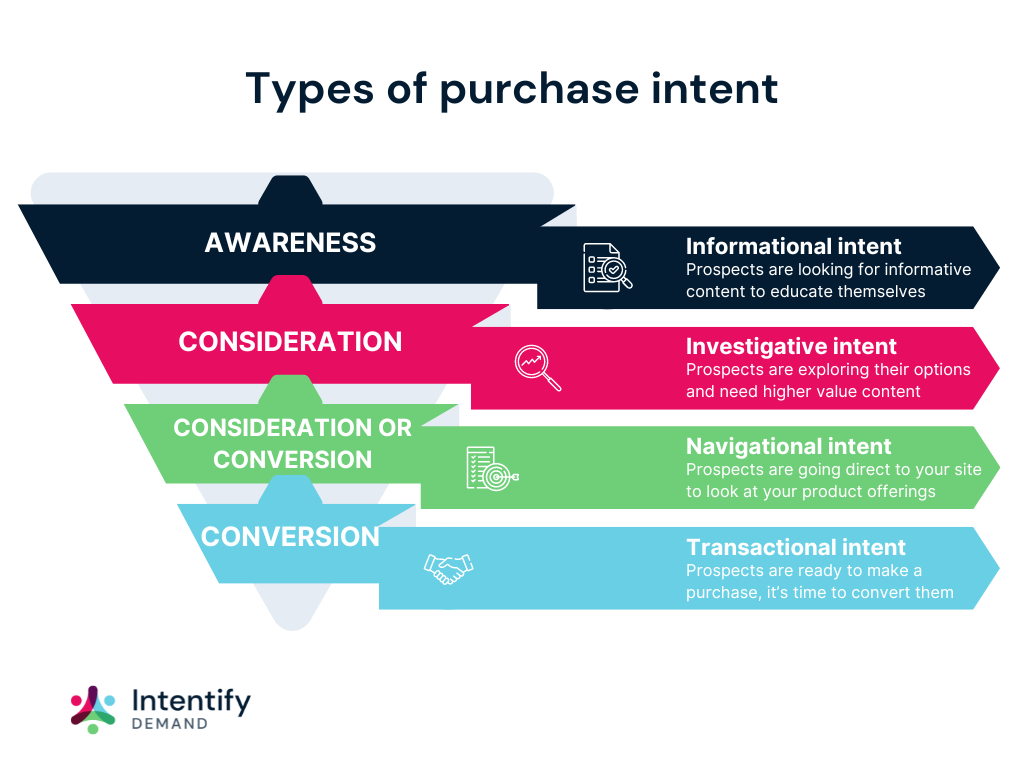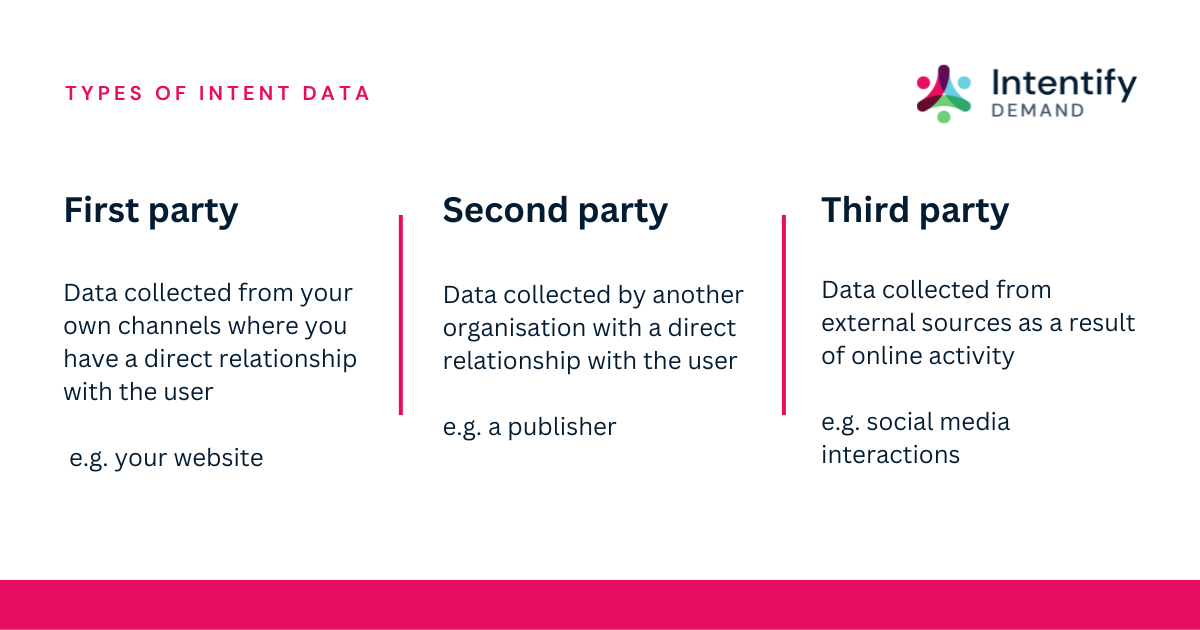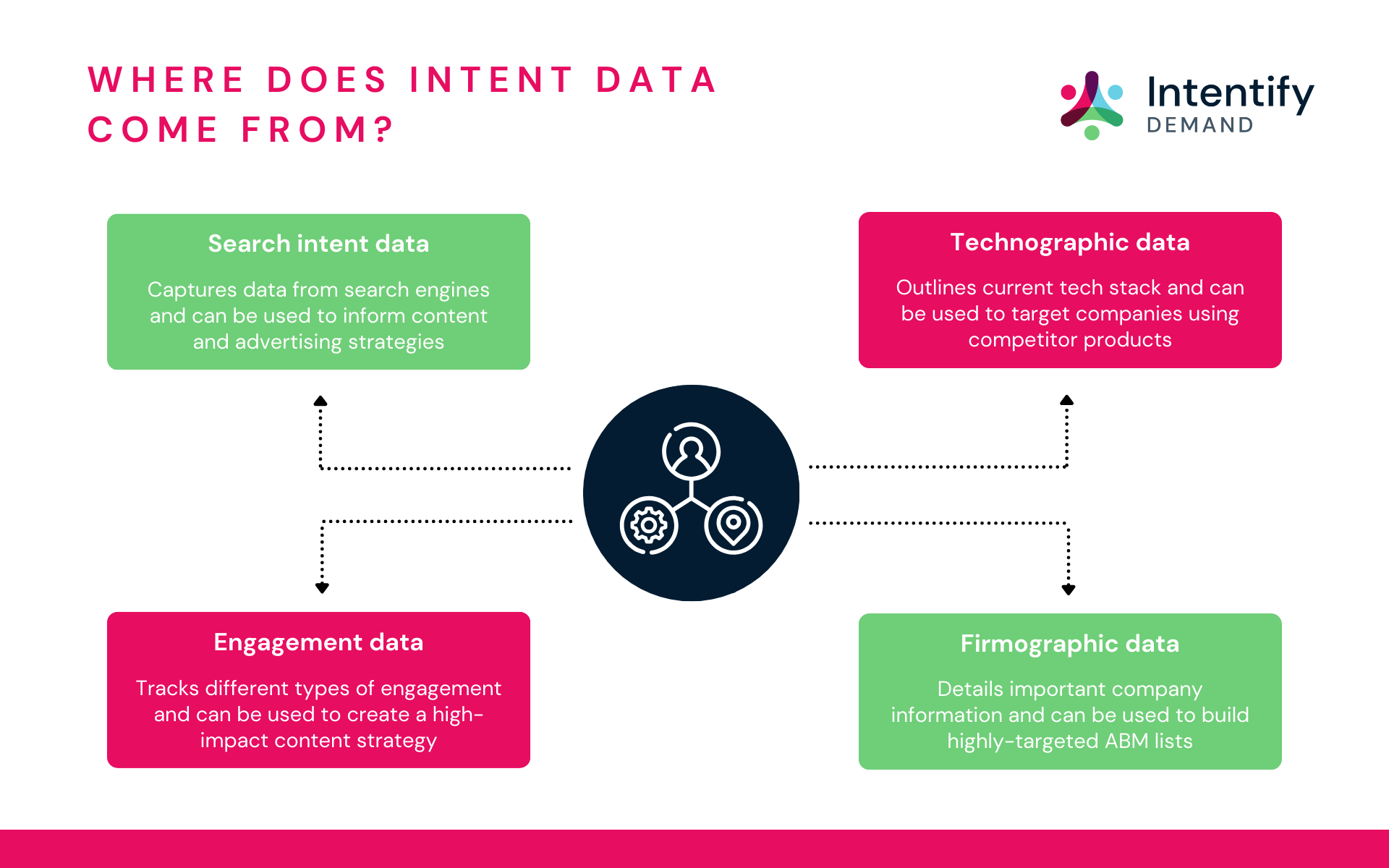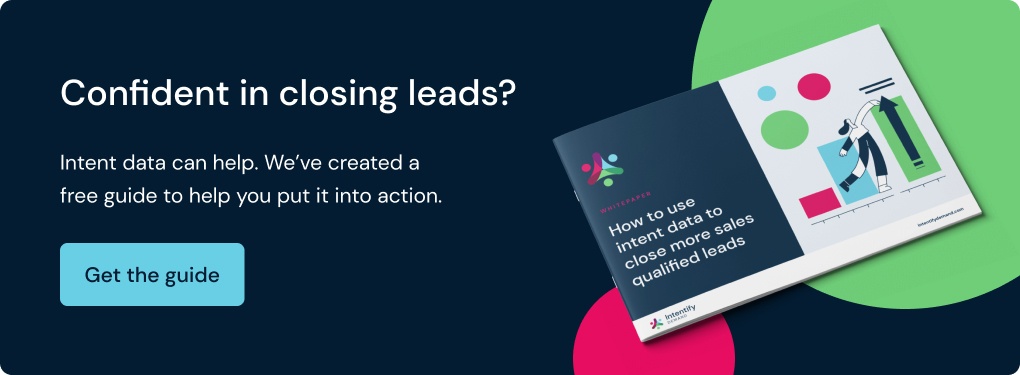Read time: 14 minutes
There’s no denying the B2B landscape has become increasingly competitive as technology has advanced. What was once dominated by just a few names is now a sprawl of unending tech stacks and tools designed to help the B2B industry be smarter, quicker and more innovative.
At the same time, the B2C landscape has shifted dramatically due to the rise of ecommerce and customer experiences which has meant the B2B space is playing catch up.
With 68% of B2B buyers conducting their own research online, decisions are often made before a buyer ever engages with your business. Saddled with longer sales cycles and bigger investments, reaching the right prospects is difficult. If only we had a crystal ball that could help us see who’s ready to buy…
Say hello to intent data.
In this article:
-
How can you use intent data in your B2B marketing strategies?
-
Using intent data to cut through in the Zero Moment of Truth
What is intent data?
Intent data refers to whether or not an individual is showing the intent to purchase.
As we navigate the web, digital signals are left behind. These come from all sorts of digital interactions, including online purchases, social media interactions, the websites we visit and the content we consume.
Recommended reading: 26 intent data terms you need to know for B2B marketing
Being able to pull all these signals together provides a clear picture of what an individual is interested in and where they might be in their buying journey. It can show an individual is in the research phase, exploring their options and seeing what’s out there. And it can show whether an individual is actively looking to make a purchase based on their behaviour.
What is purchase intent?
Also referred to as buyer intent, purchase intent refers to a prospect's intention to make a purchase. It signifies a more immediate readiness to make a purchase. It can be used to guide messaging and engagement strategies to better align with a prospect's motivations and needs, and often includes a higher likelihood of conversion.
While this type of intent data is valuable, it's important for marketers to not focus solely on it; in many cases, the ability to influence the purchasing decision at the point when the purchase intent is formed is simply too late.

What is predictive intent?
Predictive intent is a form of analytics that uses machine learning and artificial intelligence to analyse and understand historic intent data. By understanding past behaviours, it can predict who will be most likely to make a purchase and when.
For many, predictive intent can be complicated and time-consuming to set up as it requires complex algorithmic models in place. The AI will work through massive sets of buying pattern data to predict when an individual is considering a purchase.
What are the different types of intent data?
There are three different types of intent data:

First-party intent data
First-party intent data is collected from your own channels where you have a direct relationship with the individual. For example, on your website, you can see signals around topic interest based on what relevant content an individual might interact with, and more explicit signs of purchase intent if they explore your pricing page. Other examples include:
- Website visits and page views
- Webinar attendance
- Form completions
It's the most reliable form of intent data and also the most impactful as these individuals are directly interacting with your brand, however, it's not enough to rely on first-party intent data as you'll only see information from those who land on your website.
Recommended reading: How we're using first party intent data to improve your lead quality
Second-party intent data
Second-party intent data is often left out of the conversation as many don't deem it particularly valuable but second-party data is relatively unique. It's collected by another organisation that has a direct relationship with the user - essentially it's someone else's first-party data. This often comes from software review sites like G2 but could also come from a publisher.
Second-party data could be useful in helping to identify target accounts that use a competitor software, however, this type of data is mostly found lower down the funnel so their purchase intent is pretty strong. This means it could be difficult to market to them because they've either already committed to a different provider, or may have already made their decision.
Third-party intent data
Third-party intent data is collected from external sources and is generated from various online activities such as content consumption, online searches, social media interactions and more across the entire web landscape. It provides a panoramic view of industry trends, market shifts and audience behaviour yet can be limited in providing a clear view of purchase intent.
Where does intent data come from?
With so many different data sources in the current tech landscape, understanding where intent data comes from can help to interpret and analyse it effectively.

Search intent data
Search intent data refers to the information captured when individuals enter keywords or phrases into search engines like Google or Bing. This data holds significant value for marketers as it allows them to understand the queries their target audience is searching for and provide relevant answers to their questions.
To leverage search intent data effectively, incorporate these phrases and keywords your audiences are searching for into your website content, blog posts, and social media posts to enhance online visibility.
Additionally, tapping into search intent data allows marketers to optimize their advertising strategies by using tools like Google AdWords to run ads specifically targeting these keywords, thus driving more traffic to your website and attracting potential customers who are actively seeking a solution like yours.
Technographic data
Technographic data provides insights into a prospective company's technology infrastructure. By understanding the software, hardware, and networks that a company uses, marketers can tailor their offerings and marketing strategies to better meet the needs of their target customers.
For example, if a CRM software provider discovers a potential customer is using an outdated system or a competing CRM tool, they can highlight the unique features and advantages of their own software to demonstrate why it would be a better fit for the customer's needs.
This knowledge allows marketers to differentiate their offerings in a crowded market and increase their chances of closing more deals.
Engagement data
Engagement data refers to the level of interest and interaction an individual has with your content. By analyzing this data, marketers can gain insight into what types of content resonate most with their audience and use that information to refine their marketing strategies.
Additionally, engagement data can help marketers identify patterns in user behaviour and preferences. By tracking which types of content receive the most engagement, whether it's through comments, shares, or likes, marketers can tailor their content strategy accordingly.
Firmographic data
By gathering information about a prospective company's size, industry, location, and revenue, marketers can better understand their target market and tailor their messaging accordingly.
Additionally, leveraging firmographic data in combination with account-based marketing (ABM) strategies can be highly effective, allowing marketers to target specific accounts rather than broad demographics.
Why is intent data so valuable?
The ability to provide insight into buyer behaviour and determine which prospects are ready to buy takes much of the guesswork out of marketing, meaning B2B marketers can be more targeted in their approach to converting a lead.
Not only does this improve resource allocation and improve lead quality, it also powers data-driven decision-making based on real-time customer behaviour.
Pulling this all together means businesses effectively using intent data now have a more competitive edge than their rivals as they can deliver the right messaging at the right time, and to the right person.
While considering someone's intent to purchase is not a new concept, the use of intent data in marketing campaigns has certainly evolved with new and emerging technology.
Many enterprises have already incorporated buyer intent into their marketing and sales strategies, having already recognised the value of understanding customer intent. However, the availability of actionable intent insight due to the abundance of data that customers are creating and sharing has empowered businesses big and small, no matter the size of their marketing budgets.
With this influx of data, marketers are now better equipped to gain a granular view of intent and move beyond broad topics to specific keyword insights. This allows them to include an additional layer of timing, relevance, and context within their campaigns, especially when it comes to account-based targeting.
Intent data also goes beyond traditional profiling or behavioural data by providing clarity on the sentiment attached to certain topics. This means that marketers can not only understand what customers are interested in but also gauge whether the sentiment towards those topics is positive or negative. Ultimately, this more comprehensive view allows for better targeting and personalisation in marketing efforts.
Is intent data the future of B2B marketing and sales?
In short: yes. While the marketing landscape will continue to evolve, the core principles behind intent data – personalisation, data-driven decision-making and customer centricity – will continue to define and shape the future of B2B marketing and sales strategies. It’s likely that as technology advances, we’ll see intent data become even more central to driving successful business outcomes in the years to come.
With the increasing complexity of the B2B buying process, intent data helps marketers to better understand their target audience and tailor their strategies accordingly. By gathering information about which websites a potential buyer has visited, keywords they have searched for, content they have engaged with, or actions they have taken on social media platforms, B2B marketers can see exactly what their prospects are interested in.
What are the benefits of intent data?
There's no denying that intent data is changing the way marketers communicate with their prospects. In fact, there are three core ways in which intent data is beneficial to marketing teams:
1. Personalised content and messaging
In today's digital age, personalisation is key to successfully engaging with prospects and customers. Gone are the days of generic mass messaging that often fails to resonate with individuals.
By leveraging intent data, marketers can gain a deeper understanding of their prospect's interests and challenges. This knowledge allows them to deliver precise, tailored, and personalised messaging that speaks directly to the needs of each individual.
This ability to target prospects with more precision means that marketers can ensure their messaging reaches the right people at the right time, increasing the chances of conversion and ultimately generating better results.
Not only does delivering precise, tailored, and personalised messaging help businesses establish stronger connections with their prospects but it also positions them as knowledgeable experts in their field. This approach increases engagement while building trust and credibility.
2. Precise targeting
Working with intent data has shown significant benefits in lead conversion rates. Research from DemandScience claims that 87% of B2B sales teams can convert leads at least 2x faster compared to leads generated without intent data.
By integrating intent data into your marketing platforms, such as HubSpot or Marketo, marketers can derive continuous value from it. This increases the effectiveness of communications and strategic account targeting based on real-time insights.
Plus, marketers can optimize their resources and focus their efforts on the most promising prospects, leading to higher conversion rates and improved business outcomes.
3. Sales and marketing alignment
With better insight into prospect behaviour and an overall stronger marketing strategy, you can use the insights from intent data to foster collaboration between sales and marketing teams, better aligning efforts towards shared goals.
Working together to define criteria around what is a marketing qualified lead (MQL), what is a sales qualified lead (SQL), and which intent signals are the most important helps to build a communicative and collaborative relationship between sales and marketing. This alignment also strengthens a company's positioning in the market as messaging will be more cohesive as well as the overall customer experience.
Recommended reading: MQL to SQL: Easy lead qualification in just 4 steps
How can you use intent data in your B2B marketing strategies?
There’s no denying intent data is a powerful tool, but the trick is knowing how to use it. According to Gartner, 71% of B2B organisations are collecting buyer signals, yet despite this, more than half aren't using their data.
And really, there's no excuse since there’s no shortage of applications in the B2B marketing space:
1. Data analysis and segmentation
Take the time to analyse your intent data to understand behavioural patterns, and identify signals of purchase intent. It's likely you'll need a specialist platform to help with this if you don't have the data capabilities in-house.
Once you're able to analyse the signals you collect, you can segment prospects based on their level of intent, categorising them into different stages of the buying journey.
2. Account-based marketing (ABM)
Using intent data, you can identify high-value accounts that are displaying strong intent signals. Once you know who these accounts are, you can develop a personalised ABM strategy to target them in a way that’s relevant and valuable.
By combining intent data with ABM, marketing teams can enhance their understanding of target accounts' behaviours and interests. This allows for more precise targeting, better resource allocation, and improved personalization of messaging and content, all of which significantly increase the chance of converting a potential customer by engaging with them at the right moment.
3. Content alignment
With intent data, messaging, content, and resources can be better adapted and personalized to align with the specific pain points of your target accounts. This level of customization not only increases relevance but also helps establish a relationship with prospects who are actively seeking a solution to their problems.
4. Lead prioritisation and scoring
Lead scoring is crucial as it allows marketers to prioritise leads based on their likelihood of converting into customers. By incorporating buyer intent into lead scoring efforts, marketers can improve their ability to identify qualified prospects. This also ensures sales and marketing teams are focusing on leads that are showing the highest likelihood of conversion.
For instance, if a lead visits a company's pricing page or requests a quote, it indicates they have a genuine interest in the offering and are more likely to convert. This intent signal can be used to assign the lead a higher score, distinguishing them as an MQL.
Account scoring is equally important as it helps assess the potential value of target accounts. By combining various intent signals from multiple leads within an account, marketers can determine if an account is ready to be approached by the sales team.
Recommended reading: Targeted leads: Why individuals are more valuable than companies
5. Engagement and follow-up
With access to intent signals, marketers can focus on only engaging prospects with the most relevant communications.
Instead of creating generic content, using intent data insights means marketers can work with the sales teams to tailor conversations and follow-ups, addressing specific pain points or interests, therefore creating a more genuine connection.
This approach is also likely to have a higher impact with potential customers deriving value from the interactions before they commit to becoming a customer.
6. Dynamic campaign optimisation
Intent data wouldn't be effective without optimisation; it's not a set-and-forget strategy (no marketing tactic is).
Therefore, marketers need to continuously monitor and analyse their intent data so they can optimise their marketing campaigns in real-time.
Regularly re-evaluating campaign performance means you’ll be able to adjust ongoing strategies based on changing intent signals to maximise engagement and conversion rates.
7. Predictive analytics and future planning
Often, marketers perceive intent data as a short-sighted prediction of a prospect's buying intent. But it can be a lot more powerful when combined with the right tools.
Leveraging predictive analytics can help you forecast future behaviours and trends, giving you a better understanding of the market. You can then plan future marketing initiatives and product development strategies based on these insights.
Using intent data to cut through in the Zero Moment of Truth
Having a deep understanding of intent data is crucial for driving sales growth and reaching prospects in the Zero Moment of Truth (ZMoT). By knowing the intentions and needs of potential customers, sales reps can engage with them more accurately, increasing their chances of converting leads into actual sales. This approach minimizes wasted resources and ensures that sales efforts are focused on high-quality engagements.
With an intent-informed strategy, marketing and sales teams can identify and prioritize active, good-fit leads and accounts. Instead of spending time and energy on irrelevant or uninterested prospects, they can focus on those who have demonstrated a genuine interest in their product or service.
By delivering relevant, contextual information at the exact right time - the Zero Moment of Truth - marketers can have a powerful impact on potential customers. This personalized approach enhances customer experience and increases the likelihood of closing deals successfully.



